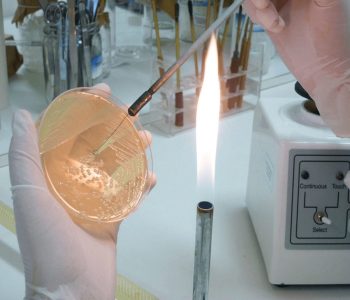A prototype of a bacteriophage-based biopharmaceutical to control avian salmonella represents an alternative to the use of antibiotics
Embrapa Swine and Poultry (SC) has been making progress in the development of a bacteriophage-based biopharmaceutical prototype to control avian salmonella, which causes contamination of chicken meat and salmonellosis in humans.
- Bacteriophages are viruses widely distributed in nature that act specifically on bacteria.
- This bactericidal action represents an alternative to the use of antibiotics.
Researchers identified and examined three of these viruses found within the microorganism collection at the facility which exhibit the essential attributes for managing specific salmonella serotypes.
The research addresses one of the current priorities in animal production – maintaining herds and flocks free of pathogens that cause foodborne diseases and ensuring the safety of products. Antimicrobial resistance is one of the most relevant topics in this context and has driven public policies by its interface with the concept of One Health, involving the interrelation of human, animal, and environmental health.
The spread of microorganisms resistant to available antimicrobials and the lack of development of new classes of antimicrobials have been a warning from experts about the future difficulty in dealing with bacteria, even in simple infections.
In alignment with national and international actions, scientists from Embrapa Swine and Poultry have been engaged in research and studies to address antimicrobial resistance and support the implementation of public policies. In addition to participating in groups such as the Codex Alimentarius Task Force on Antimicrobial Resistance, which concluded in 2021, the Unit also contributes to the National Action Plan for the Prevention and Control of Antimicrobial Resistance in Agriculture (PAN-BR Agro) with various research efforts, such as the development of biological inputs for the control of relevant bacteria in poultry farming.
According to researcher Clarissa Vaz, the leader of the project that resulted in the development of the bacteriophage-based biopharmaceutical prototype, the availability of a biological agent that prevents or reduces the use of antimicrobials and can be applied to control salmonella in poultry is desirable due to the social and economic importance of poultry production for the country and the need for prudent use of antimicrobials to preserve the effectiveness of those available.
“This input does not intend to replace the therapeutic use of antibiotics but is an option to strengthen the control of salmonellosis by reducing unnecessary antimicrobial use,” she explains.
Moreover, as per Vaz’s perspective, biological interventions relying on bacteriophages may not inherently constitute a novel development within the healthcare and animal nutrition sectors, as their bactericidal properties have been recognized for an extended period.
“The difference is that if scalable products are developed at an affordable cost and containing suitable bacteriophages, phage therapy (the use of bacteriophages against bacterial infections) is a possibility to diversify strategies for controlling avian salmonella,” she points out.
Another advantage presented by the researcher is that native bacteriophages are interesting for the development of products aimed at the domestic market because they do not introduce exotic strains into Brazilian biodiversity and have a higher probability of action against local field strains.
The challenge is to reach a market potential product.
The studies led to the development of a prototype biopharmaceutical provided to chickens through drinking water, capable of reducing the level of salmonella in the intestines of broiler chickens.
“The current challenge is to advance in the development stages up to the phase of continuous production under market conditions. This is a process that follows the logic of open innovation and benefit sharing, in which Embrapa and interested companies jointly conduct research with the goal of developing their products and increasing added value,” the researcher notes.
The three bacteriophages from the Unit’s microorganism collection are the main components of this biopharmaceutical, which improves the stability of these viruses in birds after ingestion through drinking water and remains stable during storage.
The biological product was studied for the control of S. Heidelberg in broiler chickens, with potential application against S. Enteritidis and S. Typhimurium in breeding stock, which are some of the most impactful salmonella strains in these poultry categories.
Source: Embrapa
You may also like to read: “Addressing Antibiotic Residues in Milk for Health and Sustainability”
